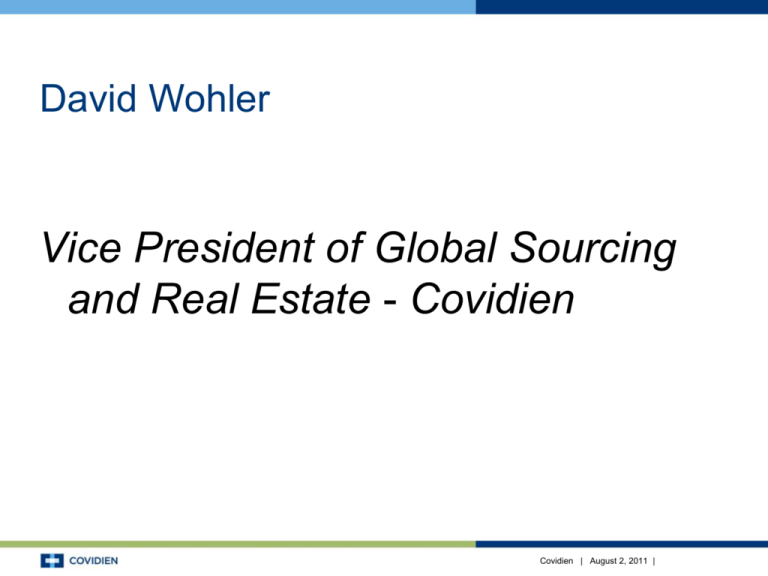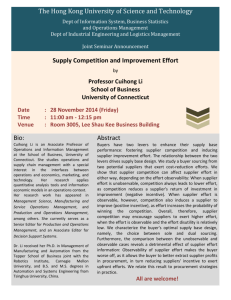
David Wohler
Vice President of Global Sourcing
and Real Estate - Covidien
Covidien | August 2, 2011 |
Driving Value from a Supplier
Relationship Management Program
David Wohler, VP Global Sourcing
• The Expectations
• Assessment Process
• Success Defined
QUALITY BEGINS WITH ME
3
QBWM: The Expectations
Suppliers shall adopt and implement a Quality Improvement strategy and
the expected elements to achieve the following:
Establish “Employee connection to the final customer i.e. the Patients”
Define the impact employee performance has on Quality of the finished product
Expected Elements
•
Implement a Recognition program to positively reinforce employees for courageous
behaviors
•
Create finished product usage and CTQs awareness through training/videos/healthcare
professional visits
•
Promote robust problem solving approach through front line employee involvement
•
Develop balanced approach to Quality and Production through line side Visible Metrics
and consistent communications
Assessment Process
• The implementation effectiveness will be assessed through :
• Audits
• Performance Review Meetings
• Self- assessments based on defined criteria
•
Effective adoption/integration of the program as assessed as above
•
Proactive identification and resolution of issues likely to impact
finished goods quality and performance
•
Favorable impact on KPIs as monitored by and/or reported to
Provider
QBWM : Engaging with Suppliers
Focus on proactive approach : Compliance and Quality
: BBQ, Product Awareness,
Communication, Blame free culture
Supporting in Implementation : Aligned with stratification
: Training
: Assessment / Report-out
: Playbook
Sharing Best Practice
: Desirable (Risk based approach)
SUPPLIER RELATIONSHIP
MANAGEMENT
Covidien | August 2, 2011 |
Supply Value Proposition
Increase business value
derived from collaboration
Collaboratively Focused
Value
Mgmt.
Role of Supply Base
Innovative/flexible
Demand
Value
Reduce demand activity,
complexity and variability
Shift from lowest price to TCO
Right goods/services at
the right price
Right goods/services at
the right time and place
Management
Total Cost of
Ownership
Purchased Cost
Reductions
Protecting the Revenue Stream
(Supply Assurance)
Transactionally Focused
Source: 2011 The Hacket Group, Inc. ; All Rights Reserved
Aligned/loyal
Operationally
excellent
Priced competitively
Reliable/solvent
Definition of SRM
Supplier Relationship Management (SRM) is a model and supporting
processes for maximizing the value of supplier relationships to the
organization over the full relationship lifecycle. SRM defines
approaches for on-going enterprise-wide interaction with suppliers as
well as with other internal company personnel to plan and manage the
relationships. SRM also defines formal mechanisms for targeting and
driving proactive value generation and managing challenges and gaps
SRM Is
SRM Is Not
• A cross functional program that aligns
supply chain activities with business
needs
• A model for managing on-going
interactions with suppliers in a way that
maximizes long-term value
• A different view or mindset of the
elements of joint Provider and supplier
success
• Just a procurement initiative
• The same thing as Strategic Sourcing or
Category Management
• A technology initiative
• Executed as a one-time project
• Managed the same way across all suppliers
• A quick fix
• A new way to get margin concessions from
the supply base
Supplier relationships will
be stratified based on
strategic importance to
prioritize resources and
tailor management
processes
Structured crossfunctional model
organized to maximize
collaboration and
effectively manage
relationships
Supplier
Stratification
Supplier
Excellence
SRM
Governance
Performance
Management
Capabilities of existing
suppliers will be
developed to deliver
continuous improvement
and proactive value
generation
Supplier performance will
be managed across
different supplier types
and strata to maximize
performance
Stratification Tiers and Logic
Supplier Criteria
Value
Creation
&
ROI
# Varies by Category
Bottom 60-80%
of Supply Base
< 3%
Definition
Strategic
Core Investing
Core
Business
Value
Exit
Provider's most strategic Suppliers with
whom the organization will develop long-term
strategic relationships to drive joint value
Medium to long-term relationships that
deliver significant value with active
management and opportunistic investment
Medium to long-term relationships that
deliver significant value. Will not require
investment
Short-term transactional
relationships with Suppliers
that meet basic
performance needs
Stratification
Stratification evaluates a Supplier’s strategic importance and
potential value
Supplier
Impact
• Criticality of
Commodity
supplied
• Role of
Supplier
• Supplier
Value
Proposition
Supplier
Alignment
• Performance
Potential
• Supply Chain
Alignment /
Scalability
• Business
Management
/ Quality
Culture
Supplier
Integration
Development
Role
• Use of
Supplier IP
• Switching
Costs
• Technical
Integration
• Access to
Advanced
Technologies
• R&D
Collaboration
Governance: Supplier Relationship Charter
Supplier Relationship Charter Document is a collaborative
document that is completed and written jointly between the parties.
Supplier Relationship Charter Document will be completed for all
Strategic and Core/Investing Suppliers.
Supplier Relationship Management – Relationship Charter
Supplier
Material / Service Provided
COV SRM Rating
Category Description
Date
Overview of the Supplier Relationship
COV
Location
Annual Spend
$MM/year
Part(s) Provided
Supplier Mfg
Location
Contract Period
TOTALS:
Key Individuals who Manage Supplier Relationship
COV Name
COV Roles
Supplier
Name
Global Sourcing Lead
Quality Lead
Executive Sponsor
(Add Additional Positions as
required)
Supplier Roles
Global Sourcing Lead
Quality Lead
Executive Sponsor
(Add Additional Positions as
required)
Partnering with key suppliers to
deliver sustainable
improvements with mutually
beneficial outcomes that will
enhance Provider’s supply base
to exceed safety, quality,
compliance, service, and cost
expectations
Proposed Scope of Supplier Excellence
Supplier Performance: Performance
Requirements
Measurements for all suppliers
•
•
•
On-Time Delivery
1st Pass Yield
Fill Rate
Core/Strategic
•
•
•
•
•
•
•
•
•
•
•
Competitiveness Measures
Innovation
# Supplier Corrective Actions / Non Conformance Reports
Customer Satisfaction
Overall Relationship Health
Diversity Spend
# Major/Minor Findings during Quality Audits
Quality Culture – Acceptance QBWM
Net Promoter Score
Total Cost of Acquisition
Performance Outcomes
Compliance to Relationship Charter
Supplier Accountability
•
•
•
Communication
Business Reviews
Scorecards
Supplier Perspective
H
S
P
E
N
D
Cash
Cow
Develop
Maintain
Monitor
M
L
M
G R O W T H
H
11 Core Skills – Global Sourcing
1. Business Intelligence: Linking and Leveraging
2. Competitive Analysis
3. Industry Analysis
4. Supplier Analysis
5. Economic Analysis
6. Sourcing Strategy Formation/Implementation
7. Competitive Bidding
8. Negotiation
9. Commercial Agreements
10.Supplier Relationship Management
11.Policy Application
Critical Success Factors
• Formal program focused on SRM development and rollout:
–
–
–
–
–
–
Single company-wide SRM program
Tangible SRM goals
Dedicated SRM team (COE)
Internal (and supplier) communication and education
On-going planning, tracking, and communication of value and wins
Common processes, policies, tools, and templates
• Active senior management leadership of the program
– Management goals include SRM rollout
– Formal senior-led program governance
• Adoption of key SRM best practices
– Focus on making strategic relationships strategic
– Aggressive rationalization of lower tier suppliers
• Systems and data aligned with SRM processes for scaled
rollout
Thank You








